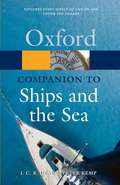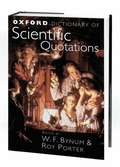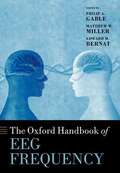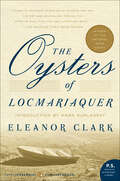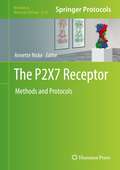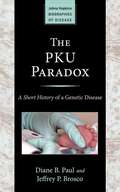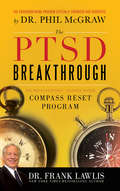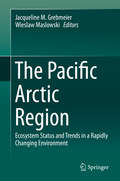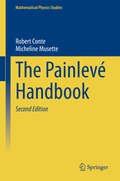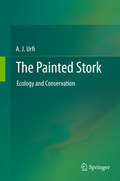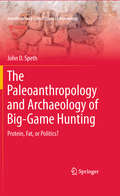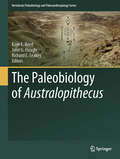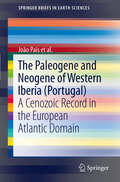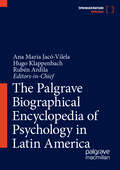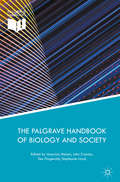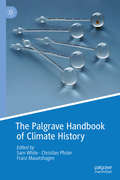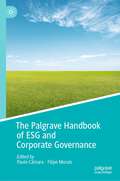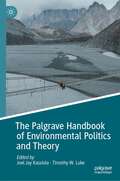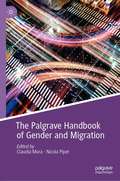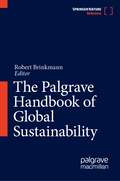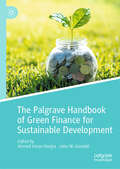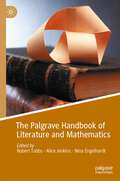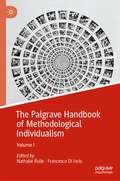- Table View
- List View
The Oxford Companion to Ships and the Sea (2nd edition)
by I. C. B. Dear Peter KempThe most comprehensive and authoritative reference book of its kind, The Oxford Companion to Ships and the Sea is a completely revised and updated edition of a classic volume that was first published in 1976, to huge acclaim. It brings together more than 2,600 entries on every imaginable aspect of the seas and the vessels that sail on them, from shipbuilding, yachting, diving, and marine mammals, to tidal power, piracy, and the literature and language of the sea. The Companion includes authoritative and fascinating entries on maritime history, including its greatest naval battles, like Pearl Harbor and Trafalgar, its most well-known ships, and its most famous individuals, both real and fictional. This second edition provides significant new material on topics that have come to prominence in recent times, such as oceanography and marine archaeology. Key contributions on these subjects include climate change, environmental issues, marine pollution, and marine wildlife. Among the many brand new entries to this edition are up-to-the-minute articles on underwater vehicles, tsunamis, warfare at sea, the Economic Exclusion Zone, and ship preservation. Entries are fully cross-referenced, and the text is now illustrated with over 260 detailed drawings, making it more accessible than ever before. It will prove an essential point of reference for anyone with a professional or amateur interest in the seas, from yachtsmen, maritime historians, and oceanographers, to naval architects, environmentalists, and armchair sailors.
The Oxford Dictionary of Scientific Quotations
by Roy Porter W. F. BynumThe original words announcing great scientific discoveries, from the first 'Eureka!' to the cloning of Dolly the sheep, can all be found in this fascinating addition to the world-famous Oxford Quotations series. An essential reference tool, put together over fifteen years with the assistance of a distinguished team of specialist advisers, it includes full author descriptions, exact sources, and a word-finding index for easy reference. Scholarly but accessible, it also presents the human face of science, as scientists reflect on achievements and failures in their own lives and those of others. For example, you've probably already hear Darwin's own thoughts on natural selection, but how about his assessment of the pros and cons of marriage? From Archimedes to Einstein and beyond, the Oxford Dictionary of Scientific Quotations charts the progress of the great ideas of science. It is an engaging and surprising read for all lovers of science, history, or wit.
The Oxford Handbook of EEG Frequency (Oxford Library of Psychology Series)
by Matthew Miller Philip Gable Edward BernatThe use of electroencephalography (EEG) to study the human mind has seen tremendous growth across a vast array of disciplines due to increased ease of use and affordability of the technology. Typically, researchers study how the magnitude of the waves changes over time or how the rhythm (frequency) of the waves changes over time. <p><p>The Oxford Handbook of EEG Frequency is arguably the first book to comprehensively describe the ways to study how the frequency of the waves changes over time and how changes in frequency are linked to cognitive, affective, and motor processes.
The Oysters of Locmariaquer
by Eleanor ClarkWinner of the National Book Award“What an elegant book this is, starting with that most elegant of creatures, the Belon oyster. . . . [Clark’s] fantastic blending of science and art, history and journalism, brings the appetite back for life and literature both.” — Los Angeles Times Book ReviewOn the northwest coast of France, just around the corner from the English Channel, is the little town of Locmariaquer (pronounced "loc-maria-care"). The inhabitants of this town have a special relationship to the world, for it is their efforts that maintain the supply of the famous Belon oysters, called les plates ("the flat ones"). A vivid account of the cultivation of Belon oysters and an excursion into the myths, legends, and rich, vibrant history of Brittany and its extraordinary people, The Oysters of Locmariaquer is also an unforgettable journey to the heart of a fascinating culture and the enthralling, accumulating drama of a unique devotion.
The P2X7 Receptor: Methods and Protocols (Methods in Molecular Biology #2510)
by Annette NickeThis detailed volume covers diverse aspects of P2X7 receptor analysis, ranging from its molecular structure to related pharmacological and immunological tools, via its analysis in heterologous expression systems as well as assays using primary cells and whole animal models. After three introductory chapters that focus on its structure, ligands, and physiological functions, the book details the generation of antibody and nanobody tools for P2X7 receptors, provides protocols for the analysis of expressed P2X7 receptors with a focus on their electrophysiological analysis, as well as protocols for the investigation of P2X7 down-stream signaling in immune cells by flow cytometry. Mouse models and procedures suited to investigate P2X7-mediated effects in other primary cells and in vivo are also explained. Written for the highly successful Methods in Molecular Biology series, chapters include introductions to their respective topics, lists of the necessary materials and reagents, step-by-step, readily reproducible laboratory protocols, and tips on troubleshooting and avoiding known pitfalls. Authoritative and practical, The P2X7 Receptor: Methods and Protocols is a valuable reference not only for the growing community fascinated by this unusual ion channel but also for a broad readership interested in ion channels or purinergic receptors.
The PCR Revolution: Basic Technologies and Applications
by Stephen A. BustinThe invention of the polymerase chain reaction (PCR) won the Nobel Prize in Chemistry in 1994 and remains one of the most important scientific discoveries of the twentieth century. More than 50,000 researchers in the United States use PCR replication technology, and yet a book has not been published on the subject in more than ten years. In this book, Dr. Stephen A. Bustin, a world-renowned PCR expert, examines in detail the latest innovations and the overall impact of PCR on many areas of molecular research. The book contains personal reflections, opinions, and comments by leading authorities on the many applications of the PCR and how this technology has revolutionized their respective areas of interest. This book conveys the ways in which PCR has overcome many obstacles in life science and clinical research and also charts the PCR's development from time-consuming, low throughput, non-quantitative procedure to today's rapid, high throughput, quantitative super method.
The PKU Paradox: A Short History of a Genetic Disease (Johns Hopkins Biographies of Disease)
by Diane B. Paul Jeffrey P. BroscoHow did a disease of marginal public health significance acquire paradigmatic status in public health and genetics? In a lifetime of practice, most physicians will never encounter a single case of PKU. Yet every physician in the industrialized world learns about the disease in medical school and, since the early 1960s, the newborn heel stick test for PKU has been mandatory in many countries. Diane B. Paul and Jeffrey P. Brosco’s beautifully written book explains this paradox.PKU (phenylketonuria) is a genetic disorder that causes severe cognitive impairment if it is not detected and treated with a strict and difficult diet. Programs to detect PKU and start treatment early are deservedly considered a public health success story. Some have traded on this success to urge expanded newborn screening, defend basic research in genetics, and confront proponents of genetic determinism. In this context, treatment for PKU is typically represented as a simple matter of adhering to a low-phenylalanine diet. In reality, the challenges of living with PKU are daunting.In this first general history of PKU, a historian and a pediatrician explore how a rare genetic disease became the object of an unprecedented system for routine testing. The PKU Paradox is informed by interviews with scientists, clinicians, policymakers, and individuals who live with the disease. The questions it raises touch on ongoing controversies about newborn screening and what happens to blood samples collected at birth.
The PTSD Breakthrough: The Revolutionary, Science-Based Compass RESET Program
by Frank Lawlis<p>We are facing a hidden and growing epidemic. More than a million veterans and everyday citizens have been affected with Post Traumatic Stress Disorder as a result of a traumatic event or personal experience. And until now, there has been little understanding of how the disorder truly takes hold and how to reverse its destruction. Finally, a breakthrough approach has been discovered. <p>Previously PTSD was treated as a psychiatric disorder only, but new scientific research shows that biological factors play just as an important of a role, specifically brain and soft-tissue damage underlying the root causes of the disorder. The PTSD Breakthrough is the first book to describe the true causes of PTSD and provide an effective program for overcoming the disorder. There is hope. <p>Through the research conducted by Dr. Lawlis and his colleagues, for the first time those who suffer from PTSD, as well as their families and loved ones, will discover that this disorder can be treated and healed, and that our veterans and all who suffer from PTSD can regain true peace in their lives. </p>
The Pacific Arctic Region
by Jacqueline M. Grebmeier Wieslaw MaslowskiThe Pacific Arctic region is experiencing rapid sea ice retreat, seawater warming, ocean acidification and biological response. Physical and biogeochemical modeling indicates the potential for step-function changes to the overall marine ecosystem. This synthesis book was coordinated within the Pacific Arctic Group, a network of international partners working in the Pacific Arctic. Chapter topics range from atmospheric and physical sciences to chemical processing and biological response to changing environmental conditions. Physical and biogeochemical modeling results highlight the need for data collection and interdisciplinary modeling activities to track and forecast the changing ecosystem of the Pacific Arctic with climate change.
The Pacific Northwest Coast: Living with the Shores of Oregon and Washington
by Paul D. KomarWhile the coast of the Pacific Northwest becomes populated with houses, condominiums, motels, and restaurants, its beaches and cliffs continue to be altered by ocean currents and winter storms. A companion volume to Living with the Shore of Puget Sound and the Georgia Strait, The Pacific Northwest Coast serves as a source of information about the coast of the Pacific Northwest, its geological setting, the natural responses of beaches and cliffs to ocean processes, and the ever-present problem of erosion.In this guide, Paul D. Komar, one of the nation's leading coastal oceanographers, examines the lessons taught by ages of geological and cultural history. With explanations of the area's geological evolution, including natural shoreline erosion and sea-cliff landsliding, Komar details human interaction with the coast: erosion caused by early settlers, the development and destruction of Bayocean Spit, the disastrous effects caused by the 1982-1983 El Niño, and the notorious failure of a construction project on the picturesqueæbut unstableæbluffs at Jump-Off Joe. Emphasizing the actual and potential harm to human projects and to the natural heritage of the coast, Komar provides the knowledge necessary for finding a safe home near the shore while preserving the beauty that draws us to it.
The Painlevé Handbook (Mathematical Physics Studies)
by Robert Conte Micheline MusetteThis book, now in its second edition, introduces the singularity analysis of differential and difference equations via the Painlevé test and shows how Painlevé analysis provides a powerful algorithmic approach to building explicit solutions to nonlinear ordinary and partial differential equations. It is illustrated with integrable equations such as the nonlinear Schrödinger equation, the Korteweg-de Vries equation, Hénon-Heiles type Hamiltonians, and numerous physically relevant examples such as the Kuramoto-Sivashinsky equation, the Kolmogorov-Petrovski-Piskunov equation, and mainly the cubic and quintic Ginzburg-Landau equations. Extensively revised, updated, and expanded, this new edition includes: recent insights from Nevanlinna theory and analysis on both the cubic and quintic Ginzburg-Landau equations; a close look at physical problems involving the sixth Painlevé function; and an overview of new results since the book’s original publication with special focus on finite difference equations. The book features tutorials, appendices, and comprehensive references, and will appeal to graduate students and researchers in both mathematics and the physical sciences.
The Painted Stork
by A. J. UrfiThe book will cover the entire range of the Painted Stork--beyond its stronghold in India and Sri Lanka to other countries--E Asia as well. For the sake of comparison, relevant information will be included about the other species of storks--both solitary as well as colonial, of Asia, as well as those in other parts of the world. Certainly plenty of references will be made about the work done on the American Wood Stork. Studies are underway in order to better understand the role of the monsoon rains on the nesting pattern of Painted Stork, besides attempting a review of the global status of the species. The former is likely to be of interest in augmenting our understanding about how global climate change is going to affect birds across India and the second is likely to raise interesting points about the distribution of species and their ranges. Both these studies will be carried through 2009 and should hopefully be included in the proposed book. Naturally, the focused interest in field research on the Painted Stork has resulted in accumulation of considerable information on this particular species, which is beyond the information contained on some standard Indian and international works and ornithological texts. The author hopes to include the entire spread of information of this species--from its systematics, evolution, distribution, ecology to its role in human culture as well as its association with mythologies. In other words, topics have not been restricted to the areas of the author's research but have spilled over into areas of anthropology, ecology, conservation, etc.
The Paleoanthropology and Archaeology of Big-Game Hunting
by John D. SpethSince its inception, paleoanthropology has been closely wedded to the idea that big-game hunting by our hominin ancestors arose, first and foremost, as a means for acquiring energy and vital nutrients. This assumption has rarely been questioned, and seems intuitively obvious--meat is a nutrient-rich food with the ideal array of amino acids, and big animals provide meat in large, convenient packages. Through new research, the author of this volume provides a strong argument that the primary goals of big-game hunting were actually social and political--increasing hunter's prestige and standing--and that the nutritional component was just an added bonus. Through a comprehensive, interdisciplinary research approach, the author examines the historical and current perceptions of protein as an important nutrient source, the biological impact of a high-protein diet and the evidence of this in the archaeological record, and provides a compelling reexamination of this long-held conclusion. This volume will be of interest to researchers in Archaeology, Evolutionary Biology, and Paleoanthropology, particularly those studying diet and nutrition.
The Paleobiology of Australopithecus
by Richard E. Leakey Kaye E. Reed John G. FleagleAustralopithecus species have been the topic of much debate in palaeoanthropology since Raymond Dart described the first species, Australopithecus africanus, in 1925. This volume synthesizes the geological and paleontological context of the species in East and South Africa; covers individual sites, such as Dikika, Hadar, Sterkfontein, and Malapa; debates the alpha taxonomy of some of the species; and addresses questions regarding the movements of the species across the continent. Additional chapters discuss the genus in terms of sexual dimorphism, diet reconstruction using microwear and isotopic methodologies, postural and locomotor behavior, and ontogeny.
The Paleogene and Neogene of Western Iberia (Portugal)
by João PaisThis volume includes a general description of the Portuguese Cenozoic basins in the Iberian tectonic context. The main stratigraphic units, including sedimentological, stratigraphical and palaeontological data, are characterized. Correlations between different sectors are presented as well as general paleogeographical evolution maps. The volume includes a general bibliography concerning the Cenozoic of Portugal.
The Palgrave Biographical Encyclopedia of Psychology in Latin America
by Rubén Ardila Ana Maria Jacó-Vilela Hugo KlappenbachThis biographical encyclopedia will provide the first comprehensive reference work on leading scholars and professionals who have contributed to the development and institutionalization of psychology in Latin America. The figures biographed will include scholars who have made a significant theoretical contribution to the discipline, as well as, practitioners and those who have contributed to the institutionalization of psychology, through their work in scientific organisations, professional bodies and publications. All persons included are recognized authorities and either natives of, or long-term residents in the region. It will offer an invaluable reference point, in particular for scholars of the history of psychology, Latin American studies, the history of science, and global psychology; as well as for historians, psychologists and social scientists seeking international perspectives on the development of the discipline.
The Palgrave Handbook of Biology and Society
by Maurizio Meloni John Cromby Des Fitzgerald Stephanie LloydThis comprehensive handbook synthesizes the often-fractured relationship between the study of biology and the study of society. Bringing together a compelling array of interdisciplinary contributions, the authors demonstrate how nuanced attention to both the biological and social sciences opens up novel perspectives upon some of the most significant sociological, anthropological, philosophical and biological questions of our era. The six sections cover topics ranging from genomics and epigenetics, to neuroscience and psychology to social epidemiology and medicine. The authors collaboratively present state-of-the-art research and perspectives in some of the most intriguing areas of what can be called biosocial and biocultural approaches, demonstrating how quickly we are moving beyond the acrimonious debates that characterized the border between biology and society for most of the twentieth century. This landmark volume will be an extremely valuable resource for scholars and practitioners in all areas of the social and biological sciences. Chapter 37 of this book is open access under a CC BY 4. 0 license via link. springer. com.
The Palgrave Handbook of Climate History
by Sam White Christian Pfister Franz MauelshagenThis handbook offers the first comprehensive, state-of-the-field guide to past weather and climate and their role in human societies. Bringing together dozens of international specialists from the sciences and humanities, this volume describes the methods, sources, and major findings of historical climate reconstruction and impact research. Its chapters take the reader through each key source of past climate and weather information and each technique of analysis; through each historical period and region of the world; through the major topics of climate and history and core case studies; and finally through the history of climate ideas and science. Using clear, non-technical language, The Palgrave Handbook of Climate History serves as a textbook for students, a reference guide for specialists and an introduction to climate history for scholars and interested readers.
The Palgrave Handbook of ESG and Corporate Governance
by Filipe Morais Paulo CâmaraSince the 2008 Global Financial Crisis the prevailing economic development model based on an assumption of unlimited resources and, therefore, unlimited growth has been increasingly put into question by academics, policy-making agencies and even industry leaders themselves. Climate change, general environmental and natural resource degradation, widespread inequalities, and systemic governance failures are pressing capitalism to renew itself to deliver sustainable outcomes for a broader base of stakeholders. This has become known in more practical terms as the ESG (Environmental, Social and Governance) and responsible investment movements. The pressure to change how we organise ourselves as societies and economies has implications for how large and small corporations, public or private, are governed and to the benefit of whom. This Handbook offers a rare combination of pluralistic and multidisciplinary perspectives from law, economics, finance and management, as well as an interesting mix of latest academic thinking and practical recommendations on ESG for boards and executive teams.Should companies be governed and managed for the benefit of their shareholders alone? Can companies be governed to deliver for shareholders as well as the broader stakeholder base? How can investors allocate capital to advance sustainability? Part I provides a pluralistic discussion of some of these fundamental questions besetting academics and practitioners alike while Part II examines recent regulatory developments and assesses what may need to change in terms of law and regulation to both hold companies to account for sustainability while enabling them to continue to provide vital goods and services. Part III of the book discusses how the different types of companies and investors are currently facing the sustainability imperative and incorporating ESG factors on how they operate and invest. The concluding chapter provides an overview of the key regulatory, ecosystem and board-level gaps that require urgent and decisive action.
The Palgrave Handbook of Environmental Politics and Theory (Environmental Politics and Theory)
by Timothy W. Luke Joel Jay KassiolaThis Handbook aims to provide a unique and convenient one-volume reference work, exhibiting the latest interdisciplinary explorations in this urgently burgeoning field of intellectual and practical importance. Due to its immense range and diversity, environmental politics and theory necessarily encompasses: empirical, normative, policy, political, organizational, and activist discussions unfolding across many disciplines. It is a challenge for its practitioners, let alone newcomers, to keep informed about the ongoing developments in this fast-changing area of study and to comprehend all of their implications. Through the planned volume’s extensive scope of contributions emphasizing environmental policy issues, normative prescriptions, and implementation strategies, the next generation of thinkers and activists will have very useful profiles of the theories, concepts, organizations, and movements central to environmental politics and theory. It is the editors’ aspiration that this volume will become a go-to resource on the myriad perspectives relevant to studying and improving the environment for advanced researchers as well as an introduction to new students seeking to understand the basic foundations and recommended resolutions to many of our environmental challenges. Environmental politics is more than theory alone, so the Handbook also considers theory-action connections by highlighting the past and current: thinkers, activists, social organizations, and movements that have worked to guide contemporary societies toward a more environmentally sustainable and just global order. Chapter “Eco-Anxiety and the Responses of Ecological Citizenship and Mindfulness” is available open access under a Creative Commons Attribution 4.0 International License via link.springer.com.
The Palgrave Handbook of Gender and Migration
by Nicola Piper Claudia MoraThis handbook adopts a distinctively global and intersectional approach to gender and migration, as social class, race and ethnicity shape the process of migration in its multiple dimensions. A large range of topics exploring gender, sexuality and migration are presented, including feminist migration research, care, family, emotional labour, brain drain and gender, parenting, gendered geographies of power, modern slavery, women and refugee law, masculinities, and more. Scholars from North and South America, Europe, Asia, and Oceania delve into institutional, normative, and day-to-day practices conditioning migrants´ rights, opportunities and life chances based on material from around the world. This handbook will be of great interest to students and scholars across a range of disciplines, including Women’s and Gender Studies, Sociology, Sexuality Studies, Migration Studies, Politics, Social Policy, Public Policy, and Area Studies.
The Palgrave Handbook of Global Sustainability
by Robert BrinkmannThe field of sustainability continues to evolve as a discipline. The world is facing multiple sustainability challenges such as climate change, water depletion, ecosystem loss, and environmental racism. The Handbook of Sustainability will provide a comprehensive reference for the field that examines in depth the major themes within what are known as the three E’s of sustainability: environment, equity, and economics. These three themes will serve as the main organizing body of the work. In addition, the work will include sections on history and sustainability, major figures in the development of sustainability as a discipline, and important organizations that contributed or that continue to contribute to sustainability as a field. The work is explicitly global in scope as it considers the very different issues associated with sustainability in the global north and south
The Palgrave Handbook of Green Finance for Sustainable Development (Palgrave Studies in Impact Finance)
by Ahmed Imran Hunjra John W. GoodellThis book covers green finance with a focus on the environmental, social, and governance (ESG) consequences of green financing and its role in attaining sustainable development and a carbon-neutral economy. It provides research-based practical solutions for sustainable development, as well as insights from green finance, presenting a framework for studying green finance in the domains of accounting, banking, investing, and insurance. Of interest to academics, investors, and policymakers in green finance and development and alternative financing, the book features a global cast of contributors from both academia and practice.
The Palgrave Handbook of Literature and Mathematics
by Nina Engelhardt Alice Jenkins Robert TubbsThis handbook features essays written by both literary scholars and mathematicians that examine multiple facets of the connections between literature and mathematics. These connections range from mathematics and poetic meter to mathematics and modernism to mathematics as literature. Some chapters focus on a single author, such as mathematics and Ezra Pound, Gertrude Stein, or Charles Dickens, while others consider a mathematical topic common to two or more authors, such as squaring the circle, chaos theory, Newton’s calculus, or stochastic processes. With appeal for scholars and students in literature, mathematics, cultural history, and history of mathematics, this important volume aims to introduce the range, fertility, and complexity of the connections between mathematics, literature, and literary theory.
The Palgrave Handbook of Methodological Individualism: Volume I
by Francesco Di Iorio Nathalie BulleWhile methodological individualism is a fundamental approach within the social sciences, it is often misunderstood. This highlights the need for a discursive and up-to-date reference work analyzing this approach’s classic arguments and assumptions in the light of contemporary issues in sociology, economics and philosophy. This two-volume handbook presents the first comprehensive overview of methodological individualism. Chapters discuss historical and contemporary debates surrounding this central approach within the social sciences, as well as cutting edge developments related to the individualist tradition with philosophical and scientific implications. Bringing together multiple contributions from the world’s leading experts on this important tradition of theorizing, this collective endeavor provides teachers, researchers and students in sociology, economics, and philosophy with a reliable and critical understanding of the founding principles, key thinkers and intellectual development of MI since the late 19th century.
